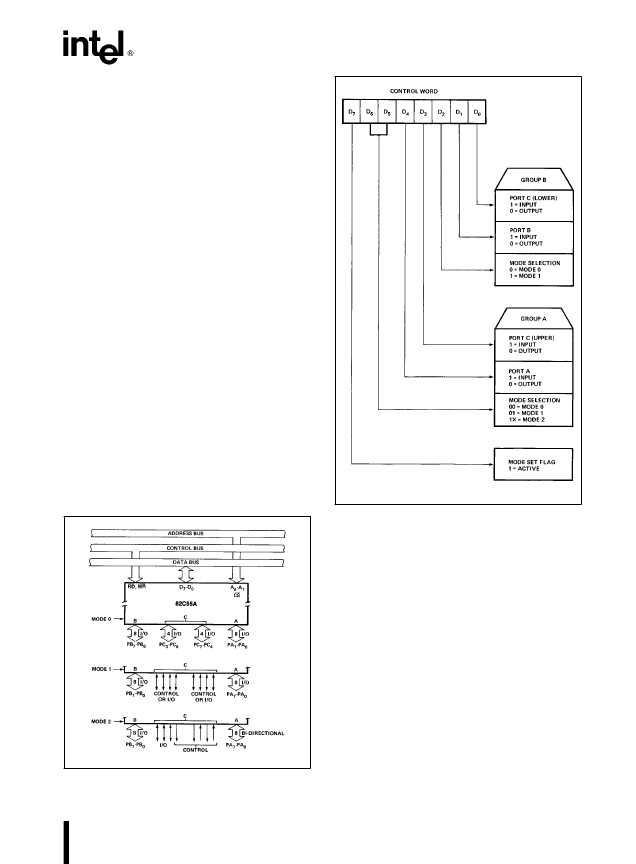- 您現(xiàn)在的位置:買(mǎi)賣(mài)IC網(wǎng) > PDF目錄369944 > P82C55A (INTEL CORP) CHMOS PROGRAMMABLE PERIPHERAL INTERFACE PDF資料下載
參數(shù)資料
| 型號(hào): | P82C55A |
| 廠商: | INTEL CORP |
| 元件分類: | 微控制器/微處理器 |
| 英文描述: | CHMOS PROGRAMMABLE PERIPHERAL INTERFACE |
| 中文描述: | 24 I/O, PIA-GENERAL PURPOSE, PDIP40 |
| 封裝: | DIP-40 |
| 文件頁(yè)數(shù): | 5/23頁(yè) |
| 文件大?。?/td> | 325K |
| 代理商: | P82C55A |
第1頁(yè)第2頁(yè)第3頁(yè)第4頁(yè)當(dāng)前第5頁(yè)第6頁(yè)第7頁(yè)第8頁(yè)第9頁(yè)第10頁(yè)第11頁(yè)第12頁(yè)第13頁(yè)第14頁(yè)第15頁(yè)第16頁(yè)第17頁(yè)第18頁(yè)第19頁(yè)第20頁(yè)第21頁(yè)第22頁(yè)第23頁(yè)

82C55A
82C55A OPERATIONAL DESCRIPTION
Mode Selection
There are three basic modes of operation that can
be selected by the system software:
Mode 0 D Basic input/output
Mode 1 D Strobed Input/output
Mode 2 D Bi-directional Bus
When the reset input goes ‘‘high’’ all ports will be set
to the input mode with all 24 port lines held at a logic
‘‘one’’ level by the internal bus hold devices (see
Figure 4 Note). After the reset is removed the
82C55A can remain in the input mode with no addi-
tional initialization required. This eliminates the need
for pullup or pulldown devices in ‘‘a(chǎn)ll CMOS’’ de-
signs. During the execution of the system program,
any of the other modes may be selected by using a
single output instruction. This allows a single
82C55A to service a variety of peripheral devices
with a simple software maintenance routine.
The modes for Port A and Port B can be separately
defined, while Port C is divided into two portions as
required by the Port A and Port B definitions. All of
the output registers, including the status flip-flops,
will be reset whenever the mode is changed. Modes
may be combined so that their functional definition
can be ‘‘tailored’’ to almost any I/O structure. For
instance; Group B can be programmed in Mode 0 to
monitor simple switch closings or display computa-
tional results, Group A could be programmed in
Mode 1 to monitor a keyboard or tape reader on an
interrupt-driven basis.
231256–5
Figure 5. Basic Mode Definitions and Bus
Interface
231256–6
Figure 6. Mode Definition Format
The mode definitions and possible mode combina-
tions may seem confusing at first but after a cursory
review of the complete device operation a simple,
logical I/O approach will surface. The design of the
82C55A has taken into account things such as effi-
cient PC board layout, control signal definition vs PC
layout and complete functional flexibility to support
almost any peripheral device with no external logic.
Such design represents the maximum use of the
available pins.
Single Bit Set/Reset Feature
Any of the eight bits of Port C can be Set or Reset
using a single OUTput instruction. This feature re-
duces software requirements in Control-based appli-
cations.
When Port C is being used as status/control for Port
A or B, these bits can be set or reset by using the Bit
Set/Reset operation just as if they were data output
ports.
5
相關(guān)PDF資料 |
PDF描述 |
|---|---|
| P8344AH | HIGH PERFORMANCE 8 BIT MICROCONTROLLER WITH ON CHIP SERIAL COMMUNICATION CONTROLLER |
| P8044AH | HIGH PERFORMANCE 8 BIT MICROCONTROLLER WITH ON CHIP SERIAL COMMUNICATION CONTROLLER |
| P8744AH | HIGH PERFORMANCE 8 BIT MICROCONTROLLER WITH ON CHIP SERIAL COMMUNICATION CONTROLLER |
| P83C524EFA | CONN, JACK MODULAR 90DEG 4P 4C |
| P83C524EFP | CONN HEADER 12POS SGL PCB 30GOLD |
相關(guān)代理商/技術(shù)參數(shù) |
參數(shù)描述 |
|---|---|
| P82C55A2 | 制造商:Intel 功能描述: |
| P82C55A-2 | 制造商:Rochester Electronics LLC 功能描述: |
| P82C574 | 制造商:未知廠家 制造商全稱:未知廠家 功能描述:Peripheral Interface |
| P82C59A2 | 制造商:INTEL 功能描述:* 制造商:Intel 功能描述: |
| P82C59A-2 | 制造商:Intel 功能描述: |
發(fā)布緊急采購(gòu),3分鐘左右您將得到回復(fù)。